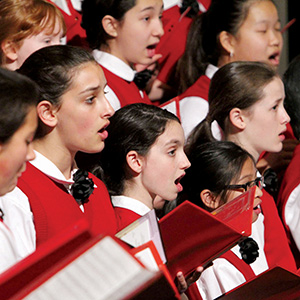Features & Columns
The Plentiful Peach Mashes Ideology and Art in Imaginative Performance
 EAST-WEST BLISS: The Los Angeles Children's Chorus helps tell a little-known tale that has been adapted for American audiences.
EAST-WEST BLISS: The Los Angeles Children's Chorus helps tell a little-known tale that has been adapted for American audiences.
Just like I'd expect from Palo Alto, the historical capital of Silicon Valley, an inspiring half-eastern and half-western collaboration will erupt this weekend.
Spacetime-continuum-channeled via Azerbaijan, Iran, San Francisco, Los Angeles, Palo Alto High and the beige corridors of SJSU's School of Music, The Plentiful Peach premieres Sunday at Stanford's Bing Concert Hall thanks to two unique talents: Niloufar Talebi on words and Mark Grey on music. Together they fuse the eastern and western hemispheres—a trans-hemispherical alchemy, I'll call it—with a chorus taking center stage, literally. Also included in the program are works by Henry Mollicone, George Gershwin and others.
A world premiere commissioned by the Los Angeles Children's Chorus, The Plentiful Peach is a coming-of-age story about a peach and the brave children who secretly grow her—against the odds. Talebi is a librettist and multiple-award-winning translator of Persian poetry who lives in San Francisco. She adapted The Plentiful Peach from an original story by the great Iranian writer Samad Behrangi. Grey, an acclaimed composer and sound engineer who went to Palo Alto High, as well as SJSU, wrote the choral score. (Empty disclosure: Grey and I are ancient friends; we were the equivalent of college fraternity bros, although we simply had the frat parties on stage.)
The original Samad Behrangi story, One Peach and 1000 Peaches, satirizes differences between the rich and poor, between privileged gluttony and poverty, between gratuitous waste and sustainability. The master takes the most fertile and watered land for himself and leaves the peasants with the unusable land while building a wall between the two worlds. A group of children employ a stealth operation to scale the wall and eat anything they can find. They stumble upon a peach, eat it, and later return to a quiet corner of the master's orchard for planting the seed. Aside from the theme of the oppressor and the oppressed, the story features viewpoints from the peach seed and the earth. Talebi was clearly moved by the original tale and I was moved just listening to her explain it over the phone.
"There's poetic line after poetic line,Ó she said. "It's a really beautiful, lyrical story that is still relevant today, in terms of sustainability and environmentalism. And it's so rich and so lyrical and so simple and profound that it was impossible not to do something with it.Ó
As a result, Talebi adapted the original story, which to her knowledge is not yet even translated into English, and then produced the libretto for The Plentiful Peach. She and Grey then discussed various narrative arcs, potential outlines, dramatic structures, compositional ideas for soloists and thematic messages they wanted to get across. During moments of the piece, Grey even sets music for children singing lines in Persian.
Talebi does not call herself a poet, but the libretto is pure poetry with multiple layers of meaning and symbolism. It really is a combo of East and West, an alchemical Sufi orchard of spiritual emotion. I'd be spoiling the peaches if I disclosed any more, but it made me want to whirl like a dervish. Or at least eat a thousand peaches.
This Sunday marks the world premiere, but this is not the first such collaboration between Grey and Talebi. In 2011, the two joined forces for Atash Sorushan (Fire Angels), which premiered at Carnegie Hall and later came to the Berkeley campus.
Behrangi (1939-1967), the original author of the peach story, was an interesting character who deserves much more attention in the West. A native of Azerbaijan, he was a notable Iranian writer and social critic who wrote, among other things, children's books that illuminated the struggles of the poor. His works highlighted the difference between the haves and have-nots, and he was a strong activist for children's education, arguing to reform what he saw as the failings of a state-sponsored education system. He mysteriously drowned in the Aras river at the age of 28 and it's widely suggested that his leftist, anti-State politics had something to do with it. This weekend, his work sees a new light, thanks to Grey and Talebi. I am whirling already.
Los Angeles Children's Chorus
April 19, 2:30pm
Bing Concert Hall, Stanford
$30-$60


